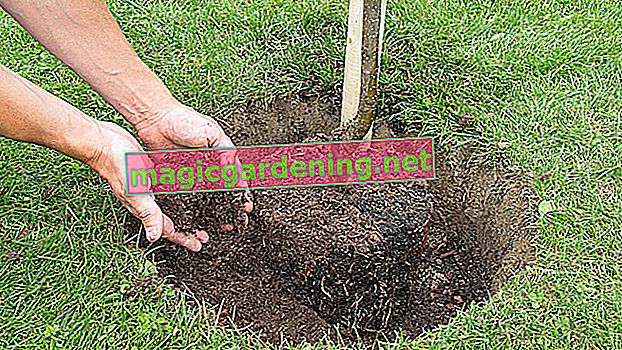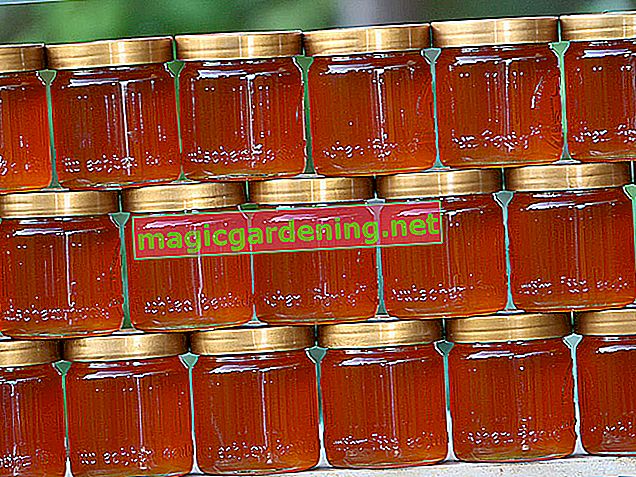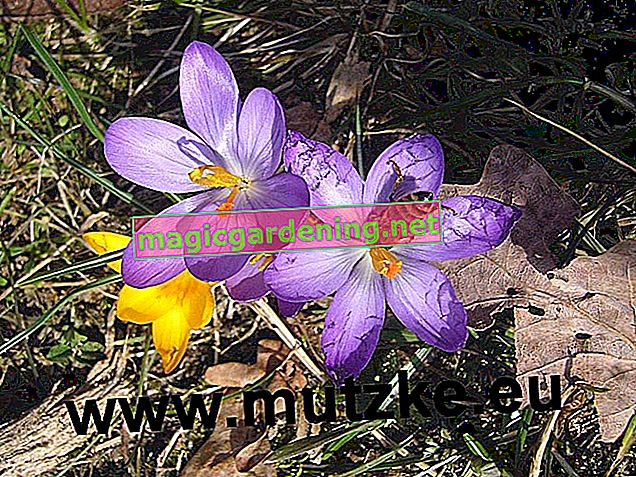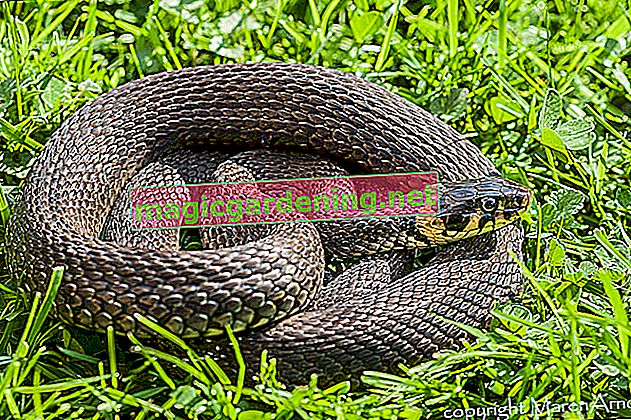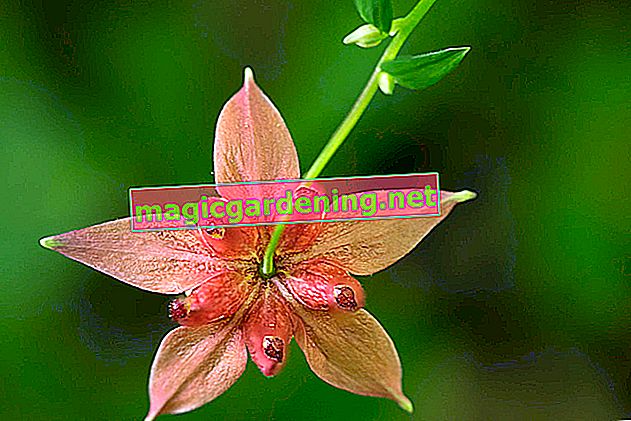
Plant columbines properly
Professional planting creates important framework conditions so that columbines create picturesque impressions in the garden for years to come. Do this as follows:
- Rake thoroughly, meticulously pull weeds, remove stones and roots
- Dig small holes at a distance of 20-30 cm
- Enrich the excavation with compost, horn meal, guano (10.44 € on Amazon *) or leaf compost
- If necessary, create a drainage at the bottom of the pit, plant the columbine in the middle and water
also read
- Planting a columbine works like this!
- Is the Columbine poisonous?
- The Columbine - perennial, but short-lived
Ideally, soak the root ball in advance until no more air bubbles rise. The planting depth in the bed corresponds to that in the nursery pot. Finally, mulch with material that is suitable for the location, such as bark mulch, grass clippings or pebbles.
Continue reading
Care tips
The care guide for a columbine does not pose any significant challenges even to beginners among hobby gardeners. How to properly handle the plant:
- If the natural rainfall is insufficient, the plant is watered
- If possible, do not water columbines overhead, but rather water them directly at the roots
- From May to August, fertilize organically with compost in the bed and liquid in the bucket
- Cut off withered material after the first flowering to attract late summer re-flowering
- Cut back close to the ground in early spring at the latest
In the year of planting and in rough locations, a layer of leaves, straw and coniferous twigs serves as protection against frost and wintry moisture. A columbine in a pot moves better to frost-free, dark winter quarters, where it is watered from time to time.
Continue reading
Which location is suitable?
The multi-faceted genus of the columbine contains an adequate species or variety for almost every location. In general, the plant thrives wonderfully in sunny to partially shaded locations, often under the influence of a wandering shade under deciduous trees. The higher a columbine stretches towards the sky, the more advantageous a sheltered location is.
Continue reading
The correct planting distance
The selected species and variety defines the specific planting distance. Take a look at the expected height and divide the value by 2, you will get the appropriate distance. For the common columbine with a height of 60 cm, a planting distance of 30 cm is ideal, while the dwarf columbine is content with a distance of 20 cm from its neighbors.
What soil does the plant need?
Thanks to its wide variety of species and varieties, you will discover a suitable columbine for every type of soil. The fundamental requirements for the earth are limited to the following attributes:
- Nutrient-rich and humic
- Fresh, moist and well drained
- Sometimes sandy-loamy to dry, but never waterlogged
In the tub, the plant thrives excellently in commercially available compost-based potting soil, which is optimized for better permeability with a handful of lava granules or expanded clay (€ 17.50 at Amazon *).
What is the best time to plant?
The planting time for columbines that have been bought ready-made and grown by hand begins in May. Say goodbye to Sophie, before you put the plant in the bed or in the pot. Direct sowing is possible from March to June, but rarely results in the desired bloom in the same year.
When is the flowering time?
The flowering period of a columbine extends from May to June. During this time, the plant presents double and unfilled flowers in white, pink, yellow and blue as well as in attractive nuances such as delicate purple, bright orange or dramatic Bordeaux red. Modern hybrids impress with contrasting colors of spores and petals.
Continue reading
Properly cut columbine
If the plant does not want to self-sow, cut off the withered flowers as soon as possible. In this way, you can also attract a second bloom in late summer. Then give the roots enough time to pull in the above-ground parts of the plant and then cut the plant close to the ground. Please wear gloves because of the high toxicity.
Continue reading
Water columbine
The casting behavior depends on the light and temperature conditions at the selected location. In the sun-drenched rock garden, the plant evaporates more moisture than in the shelter of tall deciduous trees. The thumb test provides clarity as to whether or not to water. Ideally, use the watering can nozzle to pour the water directly onto the floor and avoid showering over flowers and leaves.
Fertilize columbine properly
Do not let the plant gnaw on starvation during the growing and flowering period. Fertilize every 2-3 weeks with compost, guano, horse manure and horn shavings. (€ 6.39 at Amazon *) In the pot the columbine is grateful for liquid fertilizer, which you apply every 14 days from May to August on a previously moistened substrate.
Overwinter
With regard to the hardiness of frost, there are differences within the genus. Regardless of this, all the columbines cultivated in our gardens bravely stand up to winter without taking any special precautions. Only in the year of planting do we recommend light winter protection in the form of leaves, straw or coniferous twigs. The retracted leaves should only be cut close to the ground in early spring as natural winter protection.
For a plant in a pot, however, the privilege of carefree wintering does not apply. Ideally, you should bring the Columbine to a frost-free, dark winter quarters. Here you water from time to time so that the root ball does not dry out.
Columbine multiply
The creative gardener does not always like what the columbine produces in offspring after self-sowing. We therefore recommend dividing the rhizome in spring or autumn for the single-variety propagation of your favorite plant. Alternatively, you can purchase single-variety seeds from specialist shops. To avoid the unpredictability of direct sowing, sow from February under controlled conditions behind glass. How to do it:
- Fill the seed tray or small pots with germ-free potting soil
- Scatter the seeds and sieve 3-5 mm high
- Keep constantly moist in the partially shaded window seat at 17-20 degrees
- Prick out at a height of 5-6 cm and two pairs of leaves
A few Columbine species, such as Aquilegia chrysantha, require stratification. In this case, place the seed pot in the vegetable compartment of the refrigerator for 4 weeks and then proceed according to these brief instructions.
Continue reading
How do I transplant properly?
It is a huge rhizome with a long tap root that a columbine develops within a short time. Thanks to this root mass, the change of location is under a good star. Use this opportunity to rejuvenate and multiply the plant. How to proceed:
- In spring or autumn, loosen the root ball with the digging fork
- Lift the plant out of the earth and divide it with a spade or knife if necessary
- A vital segment has at least 2 shoots
At the new location, the planting pit has already been dug and the soil has been optimized with compost. Keep the previous planting depth and water extensively on the day itself and in the following period.
Continue reading
Columbine in a pot
In the pot, the Columbine puts its futuristic-looking flowers in the right light, but is not as long-lived as in the flower bed. Use loose, compost-based potting soil as the substrate. Some potsherds serve as drainage over the water drain in the ground, to protect against waterlogging. This is how the plant in the pot is cared for in a regular way:
- If the substrate surface dries, it is poured
- Apply liquid fertilizer every 2 weeks from May to August
- Clean up dead flowers
- Cut close to the ground after the 2nd flowering, when the leaves have withered
Before the first frost, put the columbine in the pot in the frost-free, not too bright winter quarters. Do not let the root ball dry out and stop fertilizing until April.
Is Columbine Poisonous?
The Columbine is poisonous in all parts. Even small amounts, whether consciously or unconsciously, can trigger severe symptoms of poisoning. Contact with the skin causes unpleasant irritation. Only settle the plant in the garden when small children and pets are out of reach. Long-sleeved clothing and gloves are essential for planting and care work.
Continue reading
How should the columbine be cared for after flowering?
A columbine has the potential to flower twice a year. After the first flower pile has wilted in May and June, cut the plant close to the ground and apply a dose of fertilizer. The flower sprouts again in late summer. If self-sowing is desired, leave the withered flowers on the plant. Otherwise, just cut off the flower heads so that the roots can draw in the remaining nutrients from the foliage. Only then do you cut off the columbines completely to make room for the next season.
Which neighboring plants are beneficial?
Horticultural prudence requires leaving the foliage on a columbine until the nutrients are absorbed. In this phase the plant has lost a lot of its decorative value. The choice of compatible neighboring plants is therefore becoming more relevant. These perennials solve the problem with flying colors:
- Half-height delphinium
- Summer flowering cranesbill
- Evergreen spring rose
- Silver lady's mantle
Choose summer or autumn flowering perennials with similar location requirements, which spread their leaves as a coat of charity over the now unsightly columbine foliage until it can be cut off.
Nice varieties
- Blue Star: Splendid specimen with light blue, long spurs that surround white petals; Height 60 cm
- Crystal: premium variety with pure white spurs and petals; Height 60 cm
- Maxi: yellow columbine with conspicuously swinging spurs; Growth height 75 cm
- Ministar: lime-compatible plant for the rock garden with blue-white flowers; Height of growth 15-25 cm
- Wild form: untreated by breeding, robust and long-lived Columbine; Height 50-60 cm

